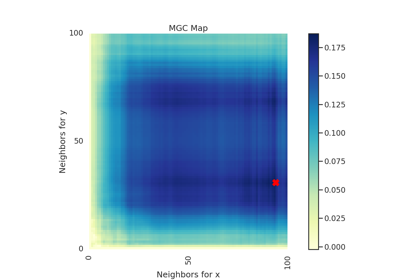MaxMargin¶
-
class
hyppo.independence.MaxMargin(indep_test, compute_distkern='euclidean', bias=False, **kwargs)¶ Maximal Margin test statistic and p-value.
This test loops over each of the dimensions of the inputs \(x\) and \(y\) and computes the desired independence test statistic. Then, the maximial test statistic is chosen 1.
The p-value returned is calculated using a permutation test using
hyppo.tools.perm_test.- Parameters
indep_test (
"CCA","Dcorr","HHG","RV","Hsic","MGC","KMERF") -- A string corresponding to the desired independence test fromhyppo.independence. This is not case sensitive.compute_distkern (
str,callable, orNone, default:"euclidean"or"gaussian") -- A function that computes the distance among the samples within each data matrix. Valid strings forcompute_distanceare, as defined insklearn.metrics.pairwise_distances,From scikit-learn: [
"euclidean","cityblock","cosine","l1","l2","manhattan"] See the documentation forscipy.spatial.distancefor details on these metrics.From scipy.spatial.distance: [
"braycurtis","canberra","chebyshev","correlation","dice","hamming","jaccard","kulsinski","mahalanobis","minkowski","rogerstanimoto","russellrao","seuclidean","sokalmichener","sokalsneath","sqeuclidean","yule"] See the documentation forscipy.spatial.distancefor details on these metrics.
Alternatively, this function computes the kernel similarity among the samples within each data matrix. Valid strings for
compute_kernelare, as defined insklearn.metrics.pairwise.pairwise_kernels,[
"additive_chi2","chi2","linear","poly","polynomial","rbf","laplacian","sigmoid","cosine"]Note
"rbf"and"gaussian"are the same metric.bias (
bool, default:False) -- Whether or not to use the biased or unbiased test statistics (forindep_test="Dcorr"andindep_test="Hsic").**kwargs -- Arbitrary keyword arguments for
compute_distkern.
Notes
Note
This algorithm is currently under review at a peer-review journal.
References
- 1
Cencheng Shen. High-Dimensional Independence Testing and Maximum Marginal Correlation. arXiv:2001.01095 [cs, stat], January 2020. arXiv:2001.01095.
Methods Summary
|
Helper function that calculates the Maximal Margin test statistic. |
|
Calculates the Maximal Margin test statistic and p-value. |
-
MaxMargin.statistic(x, y)¶ Helper function that calculates the Maximal Margin test statistic.
-
MaxMargin.test(x, y, reps=1000, workers=1, auto=True, random_state=None)¶ Calculates the Maximal Margin test statistic and p-value.
- Parameters
x,y (
ndarrayoffloat) -- Input data matrices.xandymust have the same number of samples. That is, the shapes must be(n, p)and(n, q)where n is the number of samples and p and q are the number of dimensions.reps (
int, default:1000) -- The number of replications used to estimate the null distribution when using the permutation test used to calculate the p-value.workers (
int, default:1) -- The number of cores to parallelize the p-value computation over. Supply-1to use all cores available to the Process.auto (
bool, default:True) -- Only applies to"Dcorr"and"Hsic". Automatically uses fast approximation when n and size of array is greater than 20. IfTrue, and sample size is greater than 20, thenhyppo.tools.chi2_approxwill be run. Parametersrepsandworkersare irrelevant in this case. Otherwise,hyppo.tools.perm_testwill be run.
- Returns
stat (
float) -- The computed Maximal Margin statistic.pvalue (
float) -- The computed Maximal Margin p-value.dict-- A dictionary containing optional parameters for tests that return them. See the relevant test inhyppo.independence.
Examples
>>> import numpy as np >>> from hyppo.independence import MaxMargin >>> x = np.arange(100) >>> y = x >>> stat, pvalue = MaxMargin("Dcorr").test(x, y) >>> '%.1f, %.3f' % (stat, pvalue) '1.0, 0.000'
